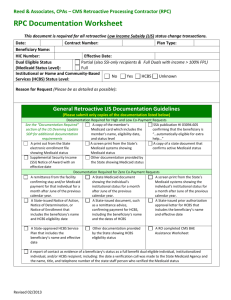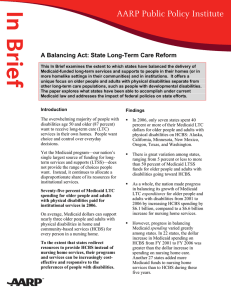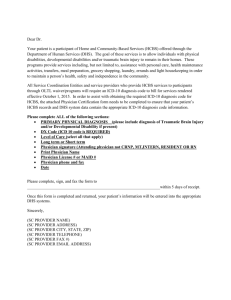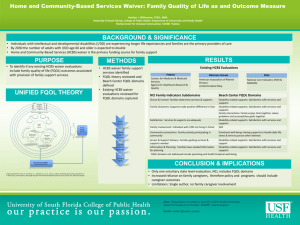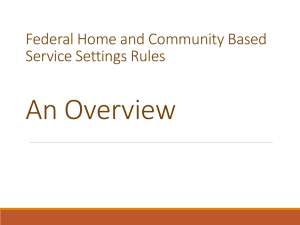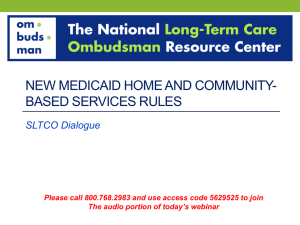STATE OF TENNESSEE - Disability Rights Wisconsin
advertisement
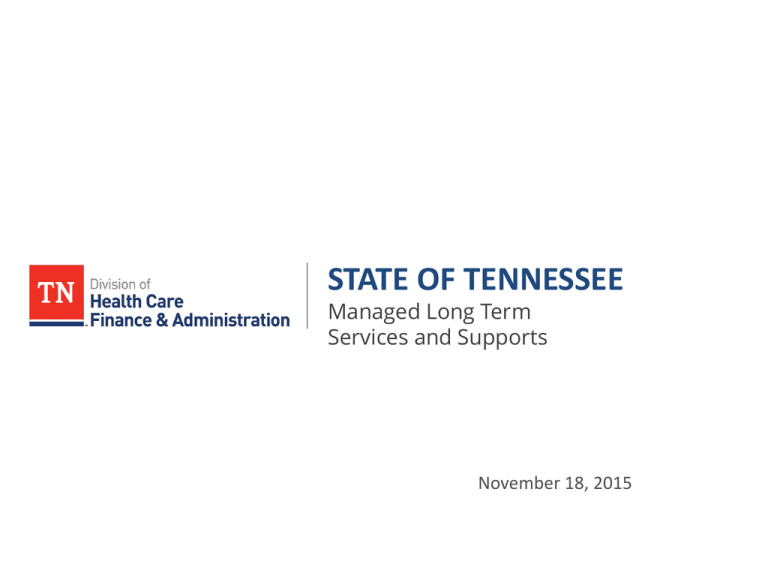
STATE OF TENNESSEE Managed Long Term Services and Supports November 18, 2015 • In 1994, Tennessee restructured its Medicaid program and became the first state in the nation to enroll its entire Medicaid population into managed care, as well as being the only state to offer Medicaid to all uninsured and uninsurable citizens – regardless of income. • This restructured and expanded Medicaid program was renamed “TennCare”. • At inception, the thought was the cost-savings from a managed care model would allow the state to cover an expanded population (individuals who would not qualify under traditional Medicaid eligibility standards) and additional benefits. • As a revolutionary model, this approach brought about some challenges which prompted the program to change and evolve to become the program it is today. 2 Carved In At TennCare’s inception, there were 12 different community service areas (CSAs) and a dozen health plans - only two were statewide. TennCare did not restrict the number of health plans; nor did it require a procurement process for plan selection. Prior to TennCare, Tennessee Medicaid was entirely fee-for-service. • 12 Plans total – 8 HMOs; 4 PPOs • Risk Model – All plans were “at-risk” • Total Enrollment – 1.1 million • • • • Physical Dental Pharmacy Routine Mental Health Services Carved Out • Long-Term Care • Specialized Mental Health Services TennCare outlined basic quality management requirements in the contracts with the health plans and contracted with an External Quality Review Organization (EQRO) to review and report on MCO quality. Out of necessity, the EQRO’s primary focus was on getting health plans to a point where they had appropriate policies in place. • Quality of encounter data – poor • Network monitoring focused on Geoaccess mapping of MCO reported primary care providers • Appeals were handled by MCOs • TennCare Satisfaction Survey: 1994 – 61% 3 By 2003, TennCare required all health plans to be HMOs and serve all areas within each Grand Region in which they participate, resulting in three Service Areas (West, Middle and East). At this time, health plans had begun to experience problems, and some were at risk of becoming insolvent which caused the state to bring them into an Administrative Service Organization (ASO) arrangement. Contributing factors included the impact of lawsuits/consent decrees and a lack of experience and capital on the part of some MCOs. • 9 plans – all HMOs • Risk Model – All plans were brought into an ASO arrangement (no risk) • Total Enrollment – 1.35 million Carved In • Physical Carved Out • • • • Behavioral Health Dental Pharmacy Long-Term Care By now the EQRO was able to focus on adherence to policies. Encounter data quality had improved. By the late 90’s, TennCare had commissioned several studies on quality including delivery of preventative services, prenatal care and ER utilization. In addition, an annual Women’s Health report was being produced. • Network requirements were expanded to include specialty standards • Management of appeals shifted to TennCare • TennCare Satisfaction Survey : 2003 – 83% 4 TennCare transitioned to three statewide MCOs and had already limited the MCO network to 3 plans. LTSS for the elderly and adults with physical disabilities has been fully integrated into the managed care model. Integration of physical health, behavioral health and LTSS services promotes improved coordination of care for the “whole person.” Further integration of LTSS services for individuals with intellectual & developmental disabilities into managed care has been designed and is scheduled to be implemented in 2016. Payment & delivery system redesign is on track to impact 80% of Tennesseans by 2020. • 3 statewide plans – all HMOs • Risk Model – At-risk • Total Enrollment – 1.4 million Carved CarvedIn In • Physical • Behavioral Health • Long-Term Care (for E/D) Carved CarvedOut Out • Dental • Pharmacy • Long-Term Care (for ID)* *ECF CHOICES planned go-live 7/2016 Today, TennCare rates above the national Medicaid average in many quality measures and continues to demonstrate improvement. With the integration of LTC into the managed care model, efforts to monitor quality of care in the elderly and disabled population are a new focus of attention. We continue to enhance quality standards – recently added contractual requirement for all plans to utilize hybrid methodology in HEDIS reporting in cases where either hybrid or administrative is acceptable to NCQA TennCare Satisfaction Survey: 2015 – 95% 5 Millions 9.0% 10.00% 7.5% 8.00% 7.0% 6.00% 3.8% 4.00% 4.1% 3.2% 2.00% 0.00% 2012 TennCare Millions Projected Medical Inflation Trends National Medicaid * 2013 Commercial Insurance** *Source: OMB 2012; Kaiser 2013 **Source: PricewaterhouseCoopers Pharmacy • Point of Sale Edits • Preferred Drug List/Drug Rebates/Generics • Prescription Limits Medical • Prior authorization • Medical Home • Network Consolidation • Disease Management • Case Management Fraud and Abuse • Narcotic Controls • Pharmacy Lock-In • Outlier Monitoring 6 2005 TennCare medical inflation trend has remained well below trends for other Medicaid agencies and Commercial plans for years. For the past 10 years we’ve consistently remained approximately 20% of state appropriations. 2010* State TennCare 2015 12 8 6 4 * So as not to under-report TennCare Appropriations, 2009, 2010 & 2011 were increased to account for ARRA. The increases for these years were taken from the 2011 Governor's Recommended Budget. 2 0 -2 ME CA MN MO AZ VT LA OK CO SD NM FL MS MA PA CT OR VA DE MD WI US Avg. ID MT TX AR OH WA IL IA AK RI WV KY NC GA IN NE AL HI UT NV WY NJ MI KS SC NY TN NH ND Percentage Points 10 Percent point increase from 2000 to 2013 in Medicaid spending as part of state budget (state dollars). http://www.pewtrusts.org/en/multimedia/data-visualizations/2014/fiscal-50#ind7 7 • In 2006, TennCare became the first state in the country to require NCQA accreditation across 100% of its fully Medicaid managed care network. • NCQA is an independent, nonprofit organization that assesses and scores managed care organization performance in the areas of quality improvement, utilization management, provider credentialing and member rights and responsibilities. • TennCare MCOs are also required to report the full set of HEDIS measures. HEDIS is a set of standardized performance measures that makes it possible to track and compare MCO performance over time. All Time High – 95% Out of 33 HEDIS measures tracked since 2007, 28 have shown improvement over time (85%). These measures include access and availability, prevention and screening, and effectiveness of care. 47 measures have shown improvement from 2014-2015 UT surveys random sampling of TennCare households for annual satisfaction report. 8 Rapidly Escalating Costs Stable Cost Trends Volatile Health Plans Experienced, Well-Capitalized Health Plans Few Quality Measures / Data Limitations NCQA Accreditation & Full Set of HEDIS Measures & CAHPS/ Improved Data Capabilities Fragmented Long-Term Services and Supports System Integrated Long-Term Services and Supports Home and Community Based Options 9 22 States Had MLTSS Programs as of May 2015 WA MN MN WI KS KS CA AZ PA PA OH IL IL NJ RI DE VA NC TN TN NM NM MA NY MI MI SC TX TX FL FL HI MLTSS implemented 1989-2004 MLTSS implemented 2005- March 2015 ©Truven Health Analytics Inc. All Rights Reserved. 10 Better Experience Coordination of services; integration with primary, acute, and behavioral Better Outcomes Health, function, quality of life Flexibility Ability to tailor unique services/supports Predictable, Managed Costs Budget stability and trend management Alignment of financial incentives Pay for quality and value Expanded access to HCBS The potential to provide services to more people and for increased flexibility in service provision—if done “right” System Balancing Increase use of community services and decrease inappropriate use of institutional services Source: Truven Health--modified 11 • Fragmented—carved out of managed care program • Limited options and choices • Heavily institutional; dependent on new $ to expand HCBS Nursing Facilities 99.26% Nursing Facilities 90.68% FY 1999 FY 2009 < 1% HCBS ~ 10% HCBS HCBS HCBS 9.32% _________________________________________________________________________ .74% • Reorganize – Decrease fragmentation and improve coordination of care. • Refocus – Increase options for those who need LTSS and their families, expanding access to HCBS so that more people can receive care in their homes and communities. • Rebalance – Serve more people using existing LTSS funds, creating a more sustainable system. • Extensive stakeholder engagement • Comprehensive LTSS system reform legislation: The Long-Term Care Community Choices Act of 2008 • Integrated TennCare nursing facility (NF) services and HCBS for the elderly and adults with physical disabilities into the existing managed care delivery system (roughly $1 billion) • Blended capitation payment for all physical, behavioral and LTC services; risk adjusted for non-LTC rate component based on health plan risk assessment scores and for LTC component based on service mix by setting (NF versus HCBS) • MCOs at full risk for all services, including NF (not time-limited) • Enrollment target for HCBS supports controlled growth while developing sufficient community infrastructure to provide care (persons transitioning from a NF and certain persons at risk of NF placement are exempt) 13 • Cost and utilization managed via individual benefit limits, levels of care (LOC), and individual cost neutrality cap • MCOs provide comprehensive person-centered care coordination, including social support needs (social determinants) o Strengthened requirements and investments in health plan and provider capacity for person-centered planning and support delivery, employment and community integration • Nursing facility diversion and transition programs, including Money Follows the Person Rebalancing Demonstration • Electronic Visit Verification system provides fiscal accountability, immediate notification/resolution of potential gaps in care o New technology engages paid caregivers as part of care team (ongoing status updates) and gathers point-of-service member satisfaction data) • Consumer direction using an employer authority model allows individuals to hire family and friends to provide HCBS 14 LTSS Enrollment before CHOICES Program (March/August 2010) LTSS Enrollment as of August 1, 2015 HCBS 17% HCBS 44% NF 57% NF 83% Nursing Facility Enrollment HCBS Enrollment 90% 90% 70% 70% 50% 50% 30% 30% 10% 10% 15 • Global budget approach: 16,000 13,409 HCBS Enrollment* 14,000 12,000 10,000 8,000 6,000 Expanded access to HCBS subject to new appropriations 6,000 4,861 4,000 HCBS enrollment without CHOICES 2,000 0 1,131 0 No state-wide HCBS alternative to NFs available before 2003. CMS approves HCBS waiver and enrollment begins in 2004. Slow growth in HCBS – enrollment reaches 1,131 after two years. HCBS enrollment at CHOICES implementation * Excludes the PACE program which serves 325 people almost exclusively in HCBS, and other limited waiver programs no longer in operation. Well over twice as many people who qualify for nursing facility care receive cost-effective HCBS without a program expansion request; additional cost of NF services if HCBS not available approx. $250 million (federal and state). Limited LTC funding spent based on needs and preferences of those who need care More cost-effective HCBS serves more people with existing LTC funds Critical as population ages and demand for LTC increases HCBS waiting list eliminated in CHOICES 16 • Number of persons receiving HCBS in CHOICES increased by nearly 170% since the program began (from 4,861 to 13,032, as of 11/1/15) • Number of persons receiving NF services in CHOICES has declined by nearly 6,000 people (from 23,076 to 17,248, as of 11/1/15) • Percentage of people coming into LTSS in a NF declined from 81.34% in the year immediately preceding CHOICES implementation to 47.93% as of 6/30/14, with more than 50% of people choosing HCBS upon enrollment in CHOICES for each of the past two years reported in the CHOICES baseline data • Average length of stay in a NF has declined from 285 days to 250 days 17 • More than 2,500 individuals transitioned from NFs to HCBS as of 6/30/14, an average of 646 individuals per year, compared to 129 people in the baseline year immediately preceding CHOICES • More than 10% of CHOICES members (1,475) receiving HCBS actively participating in Consumer Direction for some or all services; more than 300 additional persons in referral process ▫ Consumer direction options not available for this population prior to CHOICES implementation ▫ Ability to self-direct health care tasks • MCOs consistently monitoring and address potential gaps in care—for example, during the 12 month period beginning October 1, 2014 through September 30, 2015: ▫ More than 95% of all scheduled in-home care visits were completed, except for reasons initiated by the member. ▫ More than 99.5% of home care visits provided were on time, except for reasons initiated by the member. 18 • Managed care is not “the way” to improve quality and achieve savings. • There is no one “right way” to implement MLTSS. o Every state is different. o Every program is different. o Every population is different. “If you’ve seen one MLTSS program, you’ve seen one MLTSS program.” o Have to figure it out together What works for the people you want to serve (right services) In your state (right place) Now (right time) 19 • Active and ongoing stakeholder engagement is essential to designing and implementing MLTSS. o Comprehensive reform legislation: The Long Term Care Community Choices Act of 2008 o Ongoing stakeholder meetings Provider groups Advocacy groups o Mechanisms for input directly from consumers/family members CHOICES Advisory Groups Regional community forums/online surveys o Stakeholder engagement in key program design elements o Stakeholder engagement in oversight and monitoring processes 20 • Quality and cost are inextricably linked. o Coordination of care improves quality of care; higher quality care is also more cost-effective. o Integration of services that allows for coordination across the continuum has the highest potential to achieve the best quality of care and outcomes, especially for populations with complex support needs. Greatest challenge = greatest opportunity 21 • Managed care is a set of tools and principles that can help improve coordination, quality and cost-effectiveness of care for the most complex populations. It is up to us to implement those tools in the right way to achieve the desired objectives and preserve core system values. o Detailed program design and contract requirements, with aligned financial incentives and enforcement mechanisms, and appropriate reporting and monitoring processes are necessary to assure quality and compliance. Trust but verify. o One of the greatest opportunities in managed care is the opportunity to align financial incentives to achieve the outcomes that are important to you and to the people you serve. MCOs will do what you pay them to do, require them to do, 22 and hold them accountable for doing. • Working with MCOs is an accountable partnership. o Choosing the right partners is important. Procurement strategies should focus not just on managed care experience/expertise, but on experience with LTSS and with integrated approaches to planning and service delivery. Do they really understand person-centered planning? Do they understand employment and integration and know to plan and support it? Be sure your partners understand your vision, share your values, and have the ability and commitment to do it right. o You will have to invest in helping your MCOs understand your expectations and implement the program in a manner that’s consistent with your expectations. 23 • Implementing managed care “well” and achieving program objectives requires a significant investment in the State’s capacity to “manage” managed care. o It takes different kinds of skills and expertise to “manage” managed care well. o State leadership must be integrally involved in day-to-day program management and oversight and willing to hold MCOs accountable. 24 • It takes time to design and implement managed care. o Moving too quickly will undermine the success of your program. o A comprehensive readiness review strategy is critical. Show and tell. Review of key desk deliverables Onsite review of critical processes and operating functions Systems testing Key milestone deliverables o Be careful not to confuse the success of the model with the success of the implementation. 25 • It also takes time to achieve savings. o The initial focus must be on ensuring that: Members get services and providers get paid. o Assuming savings too quickly can shift the focus away from these non-negotiables and undermine quality and cost efficiency goals. 26 • • • • • • • • What do you want to achieve (change)? What do you want to preserve (sustain)? What is the best way to accomplish both of those things? What will it take to get there? How long will it take to get there? Who do you need to be sure is along for the ride? Are you ready and willing to make those investments? Who can help? 27 THANK YOU Patti Killingsworth Assistant Commissioner/Chief of LTSS Patti.Killingsworth@tn.gov TennCare MCO contract available at: http://www.tn.gov/assets/entities/te nncare/attachments/MCOStatewide Contract.pdf

